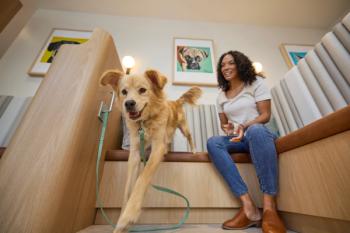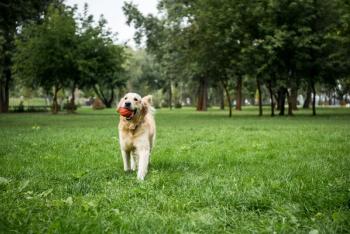
- dvm360 May-June 2025
- Volume 56
- Issue 3
- Pages: 45
Canine craniodorsal hip luxation: Management and treatment
The authors guide clinicians through the care of dogs with the condition.
Hip luxation occurs when the femoral head moves from its position in the acetabulum to a resting position that is either craniodorsal or caudoventral.
To prevent this from occurring, the ligament of the head of the femur, the dorsal acetabular rim, and the joint capsule act as major stabilizers of the hip.1 Two of these stabilizers must be disrupted for the hip to luxate. Hip luxation is common in canines, accounting for up to 90% of all joint luxations, most being craniodorsal (78%).2,3
Diagnosis
Upon presentation, typically, dogs will be non–weight bearing in the affected limb with adduction of the femur and external rotation of the stifle, swelling over the coxofemoral joint, and shortening of the affected limb. Gentle palpation may reveal crepitus in the affected hip. The orthopedic exam should specifically include thumb and triangle tests.
The thumb test requires the thumb to be placed in the ischiatic notch while externally rotating the femur. If the thumb is not displaced, the joint is likely luxated.2 The triangle test begins with pointing at the craniodorsal aspect of the iliac wing, the tuber ischii, and the greater trochanter. This should resemble a triangle with the tip pointing distally. If the greater trochanter of the femur is above the line connecting the iliac wing and the tuber ischii, the hip is luxated. Positive tests indicate that further examination of the joint is necessary. Following physical examination, sedation should be administered and pelvic radiographs obtained.
Orthogonal radiographs of the pelvis are useful to confirm luxation and assess direction of luxation, conformation of the joint (hip dysplasia), or presence of fracture of the acetabulum, fracture of the capital femoral epiphysis, fracture of the head or neck of the femur, or avascular necrosis of the femoral head (Legg-Calve-Perthes disease).
Therapeutic options
Treatment options may vary depending on the patient’s history and radiographic findings. It is important to determine whether luxation is acute or chronic.
When treating craniodorsal hip luxation, open and closed reduction are considered. Closed reduction and Ehmer sling placement should be attempted in acute cases that do not have complicating factors, whereas surgical therapies may be indicated if hip dysplasia, fractures, or chronic luxation is present.
Closed reduction should be attempted in patients who present without fractures and good hip conformation. Closed reduction and Ehmer sling placement should take place as soon as possible—ideally within the first 4 to 5 days of luxation—to decrease the likelihood of reluxation and complications.3 This requires an epidural block and heavy sedation, but preferably general anesthesia, as the procedure can be painful, and muscle contraction may result in an inability to reduce the luxation.
To reduce a luxated hip, the dog should be placed in lateral recumbency with the affected limb facing up. A towel is placed around the dog’s inguinal region, and an assistant stands on the dorsal side of the dog, pulling the towel toward them while the clinician provides distal traction and external rotation of the femur. Internal rotation will then place the femoral head back in the acetabulum when combined with abduction.1 After closed reduction, the joint should be carefully moved through range of motion while maintaining medially directed pressure on the greater trochanter to remove clots, ligaments, and the joint capsule from the joint space. The joint should be assessed for crepitus during the range of motion test, which should not be present after successful reduction. Once the joint is reduced, stability must be assessed, and an Ehmer sling should be placed to help keep the joint reduced by increasing coverage of the femoral head by abduction, internal rotation, and hip flexion. Radiographs following sling placement should be obtained to ensure appropriate seating of the femoral head. The Ehmer sling should be in place for 10 to 14 days with strict cage rest to allow healing of periarticular soft tissues and joint capsule.4 However, Ehmer slings have a high risk of bandage sores and are generally not well tolerated. Up to 50% of cases will require surgical intervention because of reluxation.2
Open reduction is indicated in cases of reluxation, where the joint remains unstable after reduction, or if closed reduction cannot be achieved.4 Additionally, open reduction is indicated with avulsion fracture of the femoral head or if the patient presents with concurrent injuries requiring immediate return to mobility. The specific procedure performed is chosen based on the patient’s age, surgeon’s preference, severity of joint capsule damage, and assessment of the joint conformation. Open stabilization techniques include capsulorrhaphy, prosthetic capsule, transposition of the greater trochanter, transarticular pinning, fascia lata loop stabilization, extra-articular iliofemoral suture, pelvic osteotomy (only in dogs typically younger than 1 year, with recurrent luxation and a mild degree of hip dysplasia), or toggle pin stabilization.
When capsulorrhaphy is performed, it is reported to have a success rate of 83% to 90%.5,6 However, in many cases, the capsule is severely torn and crushed, preventing a strong capsulorrhaphy. Other techniques are thus preferred or added to achieve stabilization, particularly in larger patients. The prosthetic capsule technique consists of screws inserted in the dorsal acetabular rim at 2 different points, with suture connecting the screws to a tunnel in the femoral neck. This technique has a success rate of 65% to 100%.7-9 Iliofemoral suture stabilization requires a tunnel to be drilled in the ilium, just cranial to the acetabulum, and 1 tunnel in the femur at the base of the greater trochanter. The suture is then passed lateral to medial through the ilium, cranial to caudal through the femur, then caudally to cranial beneath the insertion of the gluteal muscles on the greater trochanter. One study reported a variation to the technique with an anchor screw placed in the ilium.10 In young animals, a technique such as the iliofemoral suture may be advantageous because it is an extra-articular, absorbable suture and therefore can decrease the risk of degenerative joint disease and infection caused by intra-articular implants.4,11 An absorbable suture is used that decreases in tensile strength over time, allowing the surrounding soft tissues to compensate.11
Lastly, toggle pin stabilization involves a hole drilled from lateral to medial in the acetabulum and another tunnel drilled through the center of the femoral neck to exit just below the third trochanter. Anchors are then seated on the medial aspect of the acetabulum and the caudal aspect of the femur and connected with suture to hold the joint in place. This technique has a reluxation rate of 10% to 14.8%.12,13 Recently, the results of a cadaveric study showed that arthroscopic-assisted toggle pin placement is possible.14 Toggle pin stabilization is the only known technique that enables early weight bearing of the affected limb postoperatively and, therefore, is a good option when the patient has concurrent injuries.
In instances of poor hip conformation or nonreconstructable fractures, salvage procedures are typically indicated. Depending on the owner and the patient, total hip arthroplasty or a femoral head and neck ostectomy (FHO) may be performed. Total hip arthroplasty results in reconstruction of the joint with a relatively low complication rate of 6%, but reluxation is still possible.15 FHO results in the absence of a true joint, and stability relies on compensation of the surrounding tissues. Although this means there is no risk of reluxation, FHO should not be performed in cases where the coxofemoral joint may be restored.16 Small-breed dogs tend to do well with FHO, but recovery and outcome may be less favorable in large breeds or heavy dogs.
Techniques such as De Vita pin placement, external fixator, and transarticular pinning are less commonly used because of high complication rates.17 Other techniques have been described (fascia lata loop stabilization, greater trochanter transposition, transposition of sacrotuberous ligament, etc), but for which there is generally less hindsight and tend to be outdated.
Prognosis
The prognosis after hip luxation is variable, depending on the type of reduction, the delay between the trauma and reduction, the procedure performed, and the severity of the trauma. A varying degree of degenerative joint disease can be expected. The most common complication across studies after treatment was reluxation. That is why it is important to carry out a thorough assessment, taking into account all the relevant information (history, age, obesity, concurrent injuries, hip dysplasia, etc) to choose the most appropriate technique for each patient. The decision chart (Figure 1) is a useful tool for the management of coxofemoral luxation.
REFERENCES
- Harper T. Coxofemoral luxation: tips for closed reductions. University of Illinois Urbana-Champaign College of Veterinary Medicine. April 13, 2021. Accessed May 15, 2025. https://vetmed.illinois.edu/2021/04/13/coxofemoral-luxation-tips-for-closed-reductions/
- Wardlaw JL, McLaughlin R. Hip luxation. In: Johnston SA, Tobias KM, eds. Veterinary Surgery: Small Animal. 2nd ed. Elsevier; 2017:956-965.
- DeCamp CE, Johnston SA, Déjardin LM, Schaefer SL. The hip joint. In DeCamp CE, Johnston SA, Déjardin LM, Schaefer SL, eds. Brinker, Piermattei and Flo’s Handbook of Small Animal Orthopedics and Fracture Repair. 5th ed. Saunders; 2016:468-517.
- Johnston SA, Tobias KM. Veterinary Surgery: Small Animal Expert Consult. 2nd ed. Vol 1. Elsevier Saunders; 2017.
- Basher AWP, Walter MC, Newton CD. Coxofemoral luxation in the dog and cat. Vet Surg. 1986;15(5):356-362. doi:10.1111/j.1532-950X.1986.tb00243.x
- Bone DL, Walker M, Cantwell HD. Traumatic coxofemoral luxations in dogs: results of repair. Vet Surg. 1984;13(4):263-270. doi:10.1111/j.1532-950X.1984.tb00807.x
- Braden TD, Johnson ME. Technique and indications of a prosthetic capsule for repair of recurrent and chronic coxofemoral luxations. Vet Comp Ortho Traumatol. 1988;01(01):26-29. doi:10.1055/s-0038-1633158
- Johnson ME, Braden TD. A retrospective study of prosthetic capsule technique for the treatment of problem cases of dislocated hips. Vet Surg. 1987;16(5):346-351. doi:10.1111/j.1532-950X.1987.tb00965.x
- Redolfi G, Grand JG. Complications and long-term outcomes after prosthetic capsule replacement in 15 dogs with traumatic hip luxation. J Am Anim Hosp Assoc. 2023;59(2):59-68. doi:10.5326/JAAHA-MS-7244
- Rocha AG, Costa RC, Morato GO, et al. Iliofemoral technique modification using an anchor screw as treatment of canine traumatic hip luxation—case report. Arq Bras Med Vet Zootec. 2020;72(6): 2252-2258. doi:10.1590/1678-4162-12037
- Martini FM, Simonazzi, B, Del Bue M. Extra-articular absorbable suture stabilization of coxofemoral luxation in dogs. Vet Surg. 2001;30(5):468-475. doi:10.1053/jvet.2001.25875
- Mathews ME, Barnhart MD. Risk factors for reluxation after toggle rod stabilization for treatment of coxofemoral luxation in 128 dogs. Vet Surg. 2021;50(1):142-149. doi:10.1111/vsu.13498
- Trostel CT, Fox DB. Coxofemoral joint luxation in dogs treated with toggle rod stabilization: a multi-institutional retrospective review with client survey. J Am Anim Hosp Assoc. 2020;56(2):83-91. doi:10.5326/JAAHA-MS-6937
- Rivenburg RE, Murphy SM, Jones CT, Martin KW. Arthroscopicassisted toggle rod stabilization in canine coxofemoral luxation: a cadaveric study. Vet Comp Ortho Traumatol. 2022;35(5):298-304. doi:10.1055/s-0042-1748880
- Allaith S, Tucker LJ, Innes JF, et al. Outcomes and complications reported from a multiuser canine hip replacement registry over a 10-year period. Vet Surg. 2023;52(2):196-208. doi:10.1111/vsu.13885
- Harper TAM. Femoral head and neck excision. Vet Clin North Am Small Anim Pract. 2017;47(4):885-897. doi:10.1016/j.cvsm.2017.03.002
- Wardlaw J. Hip luxation (proceedings). dvm360. October 1, 2011. Accessed May 15, 2025. https://www.dvm360.com/view/hip-luxation-proceedings
Articles in this issue
5 months ago
Renovate to revitalize5 months ago
Decision-making for colic workup in the field5 months ago
Overcoming understaffing5 months ago
When clients lie about preventive dosingNewsletter
From exam room tips to practice management insights, get trusted veterinary news delivered straight to your inbox—subscribe to dvm360.






